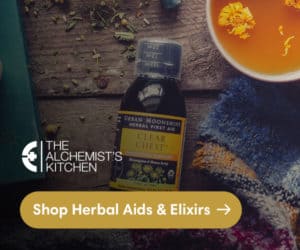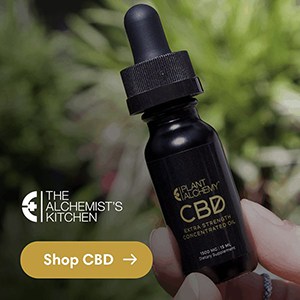Ahh, Lilac (Syringa vulgaris)—the purple, perfumed harbingers of spring! Here in the northeastern U.S., Lilacs are among the first shrubs to bloom, filling the air with their delicate scent for a few glorious weeks. They’re a common feature of colder climate gardens and landscaping due to their hardiness and delightful blossoms. I have a fondness for Lilacs, as they’re one of the first herbal friends I welcome after a long winter. I’d gather them for the aesthetic pleasure alone, but their edible and medicinal properties only add to my glee!
Etymology & Botany
Lilac, a member of the Oleaceae, or Olive family, is considered to be a large deciduous shrub or small, many-stemmed tree, which can grow up to 23 feet high. Due to the suckers it grows from its base, it will become bushy and need pruning after some years. The light purple, mauve, or white flowers bloom in dense, terminal inflorescence which may be 6 or 7 inches long. The bark is greyish or brown and the leaves are light to dark green with pinnate leaf veins, and usually arranged in opposite pairs. The fruit is a small brown capsule, just about a centimeter long, which produces winged seeds. The name Lilac comes from the Persian word līlak, a variant of nīlak which means, ‘bluish’, from nīl which means, ‘blue.’5
Traditional Uses
This flower has been appreciated, harvested, cultivated, and used for medicine and food by many different cultures in all the areas it has grown. The following is a brief overview of the recorded origins of indigenous and historic engagement.
Origin
Lilac is native to the Balkan Peninsula of Southeastern Europe, where it grows wild on rocky hills. Lilac was first formally described in 1753 in Species Plantarum by Carl Linnaeus, a Swedish botanist and early taxonomer. The shrub was introduced into northern European gardens around the close of the 16th century, from Ottoman gardens. The ambassador to The Holy Roman Emperor is generally credited with supplying Lilac slips to Carolus Clusius, an influential Flemish botanist and horticulturist about 1562.6 They became quite popular, and Lilac cultivation quickly spread throughout Europe and Britain. Lilacs were introduced to the American colonies by avid horticulturists sometime in the 18th century.2
History of Symbolism and Folklore
Lilacs have quite a rich history of symbolism and folklore. In certain tellings of an ancient Greek myth, a nymph by the name of Syringa–Lilac’s genus name!–caught the eye of Pan, god of the forest. Enamored with her grace and beauty, Pan chased Syringa through the forest. To escape him, she sought help from fellow nymphs, and was transformed into a Lilac bush. From her branches, Pan fashioned his signature flute. In the Victorian language of flowers, this herb symbolize new love, and remembrance. Lilacs have long been associated with reincarnation and the passages of life in ancient European folklore, probably due to their tendency to bloom in Spring. Orthodox Christians in Greece, Lebanon, and Cyprus associate Lilac with Easter and the resurrection story; its Greek name “pashalia” is derived from “pasha” which means “passage” in Hebrew.6 In the colonial U.S., Lilacs were often planted to mark the graves of miscarriages and stillborn children.1
Herbal Indications
Lilac is considered to be bitter, acrid, and cold energetically. The flowers are edible, and the blossoms are the only part of the plant I use medicinally. Those who run cold and dry might find Lilac increases these Vata tendencies. The following indications are the primary ways I integrate Lilac into my clinical practice.
Topical Astringent
Lilac makes a lovely astringent for the skin, soothing inflammation and toning irritated tissues. I like to make a tea of Lilac, strain it, store it in a spray bottle and apply it to rashes, acne, minor burns, and any similar affliction. Even without these issues, Lilac may be used as a daily tonic to refresh the skin. Lilac tea also makes a lovely, clarifying hair rinse–simply rinse hair with ample infusion.
Digestive Support
Due to its bitter properties, Lilac stimulates the digestive juices, relaxes smooth muscle, and gets bile flowing, which aids overall digestion and reduces gas and bloating. Tonics were taken in the 1500s in England to help improve the digestion of rich, fatty foods.1 Think of this flower in cases of abdominal bloating or discomfort. Herbalist Michael Moore writes that it is, “An excellent home remedy for menstrual cramps, bleeding hemorrhoids, and old ulcers as well as capillary ruptures from coughing or vomiting.”6
Fever Reduction
In early American herbalism, this plant has been used as a febrifuge, or an herb that helps to bring down a fever by promoting sweating. This reduces core temperature, assists the body in releasing its viral load, and calms the immune system.6 This flower has also been used successfully as an anti-periodic, or an herb that prevents the recurrence of fever-inducing disease, especially in cases of malaria.4
Contraindications
Do not use Lilac with medicines that alter blood coagulation, discontinue use two weeks before surgery, and avoid use during pregnancy. Lilac bark can be poisonous; use only the flowers. As with any herb or supplement, consult an informed herbalist or trusted healthcare practitioner before use.
Methods of Medicinal Use
Lilac, like all plants, has infinite possibilities, uses, and applications! Here are some of the more common methods we use in modern day herbalism.
Lilac Syrup
Capture the pretty purple color and floral notes of Lilac in a lovely syrup. Preparing this flower as a syrup concentrates the flower’s bitter, floral flavor and balances it with some sweetness. To make syrup, bring equal parts sugar and water to a boil in a saucepan, then add twice the volume of flowers, removed from the stem. Cover and simmer at reduced heat for 5 minutes, then remove from heat and allow mixture to infuse at room temperature for several hours, tasting occasionally, until desired intensity of flavor is achieved. Strain, bottle, and store in the fridge for 2-6 weeks. Add a spoonful to sparkling water or cocktails or enjoy it straight up!3
Lilac Tea
Lilac Tea is a straightforward preparation that can be made by pouring desired amount of just boiled water over desired amount of fresh Lilac flowers, covering, and letting steep for 10-15 minutes. Strain, and savor the unadulterated flavor and scent of Lilac in your cup! This tea makes a wonderful after-dinner digestive.
Lilac Flower Essence
A flower essence is a wonderful way to capture this flower’s energetic healing properties. Lilac flower essence is stimulating and cleansing, providing us with the new, vital energy of Spring. It helps us to release old patterns and emotions, allowing us to welcome in the magic of the present. Flower essences are best made early in the morning on a clear day. To make a flower essence, add pure spring water to an unmarked glass bowl or vessel. Calmly and intentionally harvest blossoms in full bloom (asking permission of the plant first!). Using a twig and/or leaf (not your fingers), place the flowers on the surface of the water so they float. Place the glass vessel on the ground in a peaceful place that gets full sun. Let the sun fix the vibrational qualities of the flowers into the water for several hours (meditating nearby is recommended). Next, strain the flowers out of the water and add an equal part of Brandy or alcohol preservative of choice. This mixture is the “mother essence” (do not dose directly from this mixture! First make a stock, then a dosage bottle). To make a stock bottle, add 10 drops of the mother essence to a 60 mL bottle filled with 50:50 spring water and alcohol. To make a dosage bottle, add one drop of essence from the stock bottle to a 15 mL bottle filled with 50:50 water and alcohol. Take a few drops from the dosage bottle to experience the vibrational medicine.
Growing Lilac
Lilacs can be grown from seed or even better, from cutting of a sucker, an offshoot of the root system of an established bush. Plant in spring or fall; fall is preferrable. Dig a hole for the sucker, stick it in so that several nodes are above the soil, backfill with soil, then water and wait (suckers will take 4-5 years to establish). This plant thrives in fertile, well-drained, neutral to alkaline soil (at a pH near 7.0). If your soil is in poor condition, add compost. For the best blooms, Lilacs require at least 6 hours of full sun. Alternately, more fully grown transplants are available from nurseries. Follow the instructions the nursery provides, taking care to completely cover the roots and water in.2
Sourcing Lilac
Lilac is abundant for just a brief moment in the Spring, and the flowers are best used fresh. See if you can find some growing in your yard, garden, or on the borders of local, organic farms. If you can’t find Lilac growing near you, or if it isn’t in season, it’s best to enjoy herbal preparations made with this flower. These can be ordered from reputable sources on the internet or, ideally, purchased from small, local makers and businesses, like a neighborhood herb store or health food co-op. Carefully selected, small batch herbal products with Lilac can be found at The Alchemist’s Kitchen. My favorite is this Lilac flower essence by Plant Alchemy, made with Lilacs that are biodynamically gardened in Alaska.
Sources
- Beam, Tim. “The Truth About Lilac Bushes”
- Boeckmann, Catherine. “GROWING LILACS: HOW TO PLANT, GROW, AND CARE FOR LILAC SHRUBS” – Link
- Bradley, Anna. “Lilac: An Edible and Medicinal Treat” – Link
- Grieve, Maud. “Lilacs (White and Mauve), A Modern Herbal” – Link
- Plants for a Future. “Syringa vulgaris – L.” – Link
- White Rabbit Institute of Healing. “Lilac” – Link









